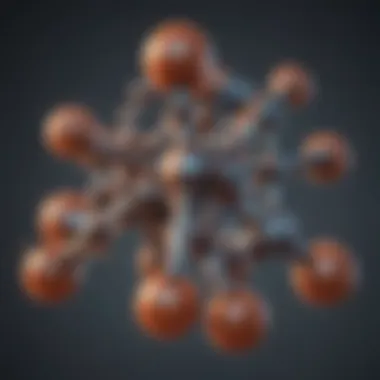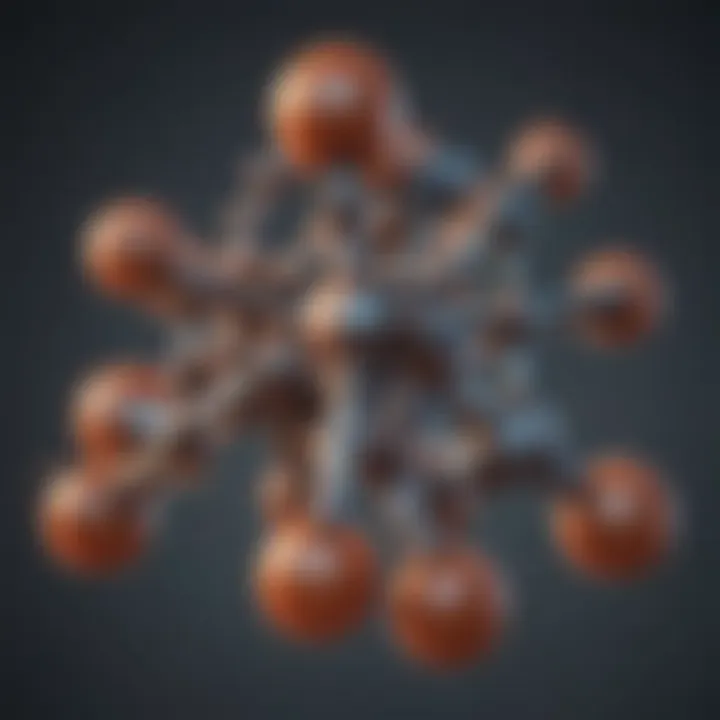Exploring the Impact of Nitrogen and Phosphate Fertilizers


Article Overview
Purpose of the Article
The landscape of agriculture is shifting dramatically, and at the heart of this transformation lies the usage of nitrogen and phosphate fertilizers. By investigating their roles and relevance, this article aims to illuminate the chemical properties of these fertilizers while also addressing their application methods and the environmental consequences of their usage. This examination is critical not only for farmers and agriculturalists but also for students and educators in the field.
Relevance to Multiple Disciplines
Nitrogen and phosphate fertilizers are not just agricultural substances; their implications touch on various fields including biology, environmental science, and even economics. As farming practices lean towards sustainability, understanding these fertilizers has become vital across different sectors:
- Agronomy: Knowledge of fertilizer application improves crop yields.
- Environmental Science: The consequences of overuse and runoff are pressing issues.
- Economics: Fertilizer costs and crop outputs influence market dynamics.
Research Background
Historical Context
The roots of fertilizer use reach back thousands of years, but it wasn't until the early 20th century that the manufacture of synthetic fertilizers took off, particularly nitrogenous and phosphate types. Historical advancements in chemistry enabled a deeper understanding of plant nutrient needs—a game changer for agriculture worldwide. The introduction of the Haber-Bosch process revolutionized nitrogen fertilizer production. Initially seen as a solution to food shortages, this innovation sparked an agricultural revolution that continues to this day.
Key Concepts and Definitions
To grasp the intricacies of nitrogen and phosphate fertilizers, a few fundamental terms and concepts must be understood:
- Nitrogen Fertilizers: These are compounds that provide plants with the essential nutrient nitrogen, crucial for growth and development. Different types, such as urea and ammonium sulfate, each come with unique properties and uses.
- Phosphate Fertilizers: These fertilizers supply phosphorus, another vital nutrient. Products like superphosphate or monoammonium phosphate are commonly found in agricultural practices.
"Understanding the balance of nutrients is paramount for sustainable agriculture."
"Understanding the balance of nutrients is paramount for sustainable agriculture."
- Sustainable Practices: This concept involves utilizing methods that meet current food needs without compromising future generations' ability to produce food. The ongoing discourse around this subject often centers on effective, responsible use of fertilizers.
By laying this groundwork, the article aims to provide the reader not just with facts but a thorough conceptual framework that illuminates how nitrogen and phosphate fertilizers operate in synergy with sustainable agricultural practices.
Prolusion to Fertilizers
Fertilizers play a critical role in maximizing agricultural productivity and enhancing soil health. The increasing demand for food, fueled by a growing global population, has led to the widespread use of fertilizers as a means of increasing crop yields. Understanding fertilizers is essential not only for farmers but also for researchers and policymakers who aim to support sustainable agricultural practices.
The core purpose of fertilizers is to replenish the soil with essential nutrients, which may have been depleted through continuous farming practices or natural erosion. Two primary elements in this arena are nitrogen and phosphate. These elements form the backbone of plant nutrition, serving distinct yet complementary roles in crop development. Dietary importance extends beyond just their presence; farmers must also know the nuanced differences in application methodologies and their specific impacts on both plant health and the environment. Additionally, examining the implications of fertilizers highlights their multifaceted nature, where benefits must be weighed against potential ecological downsides.
Understanding fertilizers isn't just about enhancing growth; it's a balancing act of harnessing agricultural prowess while safeguarding the environment. Agriculture has the task of meeting the demands of today while aspiring to protect the resources of tomorrow. The dynamics of fertilizer application and its role in soil fertility must be taken into account comprehensively.
Defining Fertilizers
Fertilizers are substances added to soil or plants to supply essential nutrients necessary for plant growth. They can be organic, derived from natural items like manure, or synthetic, involving chemical processes to create nutrient compounds. Common nutrients include nitrogen, phosphorus, potassium, and secondary nutrients like calcium, magnesium, and sulfur.
While conventional understanding often pigeonholes fertilizers into categories based on nutrient composition, many farmers today tend to focus on the specific needs of their crops. It's like cooking, really. Different dishes require different ingredients, and knowing what grows best in a given soil type or climate is key to successful cultivation. With advances in agricultural science, the role of fertilizers has evolved, shaping practices that ensure the nutrient levels of soils are harvested effectively for crop growth.
Historical Context
The history of fertilizers is as old as agriculture itself. Ancient civilizations, like the Egyptians, understood the importance of enriching their land. They utilized natural materials like fish remains, animal dung, and compost to boost soil fertility. Over the centuries, as agricultural methods became more sophisticated, so did the approaches to fertilization.
During the 19th century, industrialization gave birth to the commercial fertilizer industry. The development of synthetic nitrogen fertilizers revolutionized farming by allowing for higher yields on smaller plots of land. Countries like Germany were at the forefront of this innovation, creating products like ammonium sulfate that shaped modern agriculture.
The Green Revolution of the mid-20th century advanced these trends further. With advancements in science and technology, fertilizers became a staple in the efforts to combat food shortages worldwide. However, the widespread use of chemical fertilizers also sparked debates about environmental implications. In essence, the historical context of fertilizers lays a groundwork for understanding contemporary agricultural practices and their sustainability challenges.
"Agriculture is a science and an art. Understanding fertilizers reflects the balance between innovation and tradition, which ultimately defines successful farming practices."
"Agriculture is a science and an art. Understanding fertilizers reflects the balance between innovation and tradition, which ultimately defines successful farming practices."
By observing the trajectory of fertilizers from ancient organic compost to modern synthetic solutions, we can better appreciate their role in both food security and environmental sustainability today.
Understanding Nitrogen Fertilizers
Nitrogen fertilizers play a crucial role in modern agriculture, primarily because nitrogen is a fundamental building block for plant growth. Without adequate nitrogen, crops may exhibit stunted growth or poor yield, which directly impacts food production and quality. Understanding the variances and nuances of nitrogen fertilizers enables farmers and agronomists to make informed decisions regarding their application, maximizing productivity while minimizing environmental impacts.
Types of Nitrogen Fertilizers


Urea
Urea is one of the most widely used nitrogen fertilizers, accounting for a significant portion of global fertilizer consumption. Its high nitrogen content, around 46%, makes it highly efficient. Urea is a solid, white crystalline substance that is easy to handle and transport.
The unique feature of urea is that it acts as a slow-release fertilizer, converting to ammonia in the soil. This transformation enhances nitrogen availability to plants over time, which is beneficial for sustained growth phases. Its solubility also means it can be applied effectively using various methods. However, if improperly applied, it can lead to nitrogen loss through volatilization, particularly in high-temperature regions.
Ammonium Nitrate
Ammonium nitrate contains around 34% nitrogen and is appreciated for its fast-acting nature. It combines two forms of nitrogen: ammonium, which is more gradually available, and nitrate, which is immediately accessible for plant uptake.
This combination allows ammonium nitrate to support rapid early growth stages. Nevertheless, the compound's solubility can pose risks. Under specific conditions, it can leach away, leading to potential groundwater contamination. Factors like application timing and weather conditions must be considered when using this type of fertilizer.
Calcium Nitrate
Calcium nitrate is another excellent nitrogen source, combining about 15% nitrogen with calcium. Its dual nutrient profile is particularly useful in conditions where calcium deficiency is a concern, such as in certain soils.
Furthermore, calcium nitrate enhances the uptake of other essential nutrients, contributing to better overall plant health. Its ability to promote root development is another key advantage. Despite its beneficial characteristics, calcium nitrate is generally more expensive compared to other nitrogen fertilizers, which may deter its adoption in some farming operations.
Mechanism of Action
Nitrogen fertilizers essentially alter the nitrogen status in the soil. When applied, they break down into constituent forms that plants can use. Urea, for example, undergoes hydrolysis and becomes ammonium, a nitrogen form that roots can absorb. Similarly, ammonium nitrate dissociates in soil solution, allowing plants to access both ammonium and nitrate forms. This mechanism is pivotal in helping crops to synthesize proteins, enzymes, and other vital compounds necessary for growth.
Application Techniques
Application techniques for nitrogen fertilizers vary significantly, affecting efficiency and outcome.
Broadcasting
Broadcasting involves spreading fertilizer evenly over the soil surface. This method is often employed for its simplicity and efficiency, especially in large fields. It allows for quick applications and covers extensive areas. However, one of its disadvantages is that surface broadcasting may lead to nutrient losses through volatilization or run-off.
Banding
In contrast, banding deposits fertilizers in specific bands within the soil, usually near the seed. This technique minimizes nutrient loss and ensures better access for plant roots. Banding can also reduce competition between soil microbes and plants for nutrients, making it a preferred choice for a more targeted approach. However, it requires specialized equipment and is often more labor-intensive.
Foliar Feeding
Foliar feeding is an innovative technique that involves applying fertilizers directly to the leaves of plants. This technique allows for rapid nutrient absorption, addressing specific deficiencies promptly. Although it can be a valuable supplement to soil fertilizers, reliance solely on foliar feeding may not provide the balanced nutrition crops need throughout their growth cycle.
"Understanding the applications and nuances of nitrogen fertilizers is not just a technical capability; it’s essential for sustainable agricultural practices that protect our soil and waters."
"Understanding the applications and nuances of nitrogen fertilizers is not just a technical capability; it’s essential for sustainable agricultural practices that protect our soil and waters."
Exploring Phosphate Fertilizers
Phosphate fertilizers play a crucial role in the nutrition of crops, often overlooked in discussions about agricultural inputs. Their significance stretches beyond basic feed for plants; phosphate aids in vital processes such as photosynthesis and energy transfer within plants. Increasing awareness of the economic and environmental factors surrounding agriculture has brought phosphate fertilizers into sharper focus. Understanding the specific forms and functionalities of these fertilizers can help optimize their use in sustainable agriculture.
Forms of Phosphate Fertilizers
Phosphate fertilizers come in various forms, with each type serving different purposes and exhibiting distinct characteristics. The two primary forms are Monoammonium Phosphate (MAP) and Diammonium Phosphate (DAP). Each of these forms has unique contributions to the overall topic of phosphate use in agriculture.
Monoammonium Phosphate
MAP consists of one molecule of ammonium and one of phosphate, making it a highly efficient choice for plant growth. One of the most significant aspects of MAP is its excellent solubility, allowing it to dissolve quickly in soil. This characteristic ensures that the nutrients are readily available for plants when they are needed most, particularly during their early growth stages.
A key feature of MAP is that it provides both nitrogen and phosphorus, beneficial in supporting root development, especially in young plants. MAP is also less acidic than other forms, which is particularly crucial when dealing with alkaline soils. However, one downside to MAP is its potential for salt accumulation, particularly in areas with poor drainage. This can lead to salinity issues, so it’s vital to monitor application rates carefully.
Diammonium Phosphate
On the other hand, DAP contains two ammonium ions and one phosphate ion. This fertilizer is notably one of the most widely used around the globe. Its high phosphorus content makes it a popular choice for many crops. A standout trait of DAP is its capacity to elevate soil pH in acidic conditions, which can be advantageous in certain contexts.
Another benefit of DAP is its lower manufacturing costs compared to alternatives, making it a favorable option, especially for large-scale agricultural operations. However, the rapid release of nutrients can sometimes lead to inefficiencies if crops are unable to absorb them quickly, resulting in some loss to the environment. Understanding these nuances allows farmers to make informed decisions on which form to utilize.
Functionality in Plant Growth
Phosphate fertilizers are not just about adding nutrients to the soil; they significantly influence plant vitality. Phosphorus aids in the formation of crucial compounds such as ATP, which is essential for energy transfer in living cells. Besides energizing plants, phosphorus contributes to root development, flowering, and seed production.


Methods of Application
Understanding how to apply phosphate fertilizers effectively can make all the difference in capturing their benefits.
Placement Techniques
Placement techniques refer to how fertilizers are distributed in relation to plant roots. Surface application is one method, which involves spreading fertilizers on top of the soil. While this method can be convenient, it runs the risk of nutrient loss through runoff. Another effective technique is banding, where the fertilizer is placed in a concentrated band close to the root zone. Banding can significantly increase nutrient uptake by roots and minimizes waste.
Additionally, there is the option of incorporating fertilizers into the soil. This method helps ensure that the nutrients are available at rooting depth. Yet, incorporation requires additional labor and can disrupt existing soil structure if not done carefully.
Timing of Application
Timing is equally as necessary as method when applying phosphate fertilizers. Key moments include pre-plant, at planting, or during critical growth periods. For instance, applying phosphorus before planting can give crops a head start, whereas side-dressing during growth ensures ongoing nutrient availability. Proper timing ensures that plants can absorb the nutrients when they are most crucial, ultimately leading to better growth and yield outcomes.
In summary, exploring phosphate fertilizers cements their status as vital components for effective agricultural practices. Their unique compositions and methods of application underscore the importance of tailored approaches to fertilizer use, making it beneficial for crop yield and environmental sustainability.
The Role of Nitrogen and Phosphate in Agriculture
Nitrogen and phosphate play indispensable roles in the realm of agriculture, rendered vital for crop production and soil health. Understanding these elements is not merely an academic exercise but a key component of sustainable farming practices. Their significance can be distilled into a couple of crucial points, which I'll elaborate on below.
Nutritional Importance
Nitrogen and phosphate are fundamental nutrients for plants. Nitrogen, primarily responsible for the development of green foliage, is a building block of amino acids, which in turn form proteins essential for plant growth. Without sufficient nitrogen, plants often exhibit stunted growth or chlorosis, where leaves turn yellow, effectively signaling nutrient deficiency.
On the other hand, phosphate facilitates root development and energy transfer through adenosine triphosphate (ATP), which all organisms, including plants, use to store and transfer energy. This nutrient is linked to flowering and fruiting, making it essential for increasing yields. When crops are planted in soils low in these nutrients, the impact can be immediate and detrimental, impacting not just the current growing season but also subsequent harvests.
Moreover, the balance of these nutrients is equally as important as their presence. Too much nitrogen can lead to lush vegetative growth at the expense of reproductive structures, while excessive phosphates might lead to imbalances that affect soil microbiomes.
"Plants are like people; they need the right diet to thrive. Too much of a good thing can even be harmful."
"Plants are like people; they need the right diet to thrive. Too much of a good thing can even be harmful."
Economic Implications
Beyond their nutritional roles, nitrogen and phosphate fertilizers bear considerable economic implications. The growth of agriculture globally can be traced back, in part, to the synthetic production of these fertilizers. This surge has bolstered food production, keeping pace with a rapidly growing population. The increased yield from nitrogen and phosphate usage translates to higher income for farmers and can contribute to national food security.
However, the economic advantages come with a caveat. The costs of synthetic fertilizers can be significant, especially for smallholder farmers or those in developing countries. Prices fluctuate based on a myriad of factors, including global demand, production costs, and regulatory policies. Farmers must consider these costs while planning their crop cycles and profitability.
The market for organic alternatives is also growing, offering potential economic benefits for those transitioning toward more sustainable practices. Integrating organic matter for nutrient replenishment can often lead to lower long-term costs, though the initial phases may present challenges in terms of scale and infrastructure.
Environmental Considerations
The discussion around nitrogen and phosphate fertilizers cannot escape the overarching relevance of environmental considerations. As agriculture continues to expand, it stands at a crossroads where productivity must harmonize with ecological integrity. This balance is crucial because the misuse of fertilizers can significantly compromise soil health, contaminate water sources, and diminish biodiversity. Thus, understanding how these fertilizers interact with the environment is vital not just for sustainable agriculture but also for the maintenance of our ecosystems.
Soil Health
Healthy soil serves as the foundation for vibrant plant growth. However, the excessive application of nitrogen and phosphate fertilizers can lead to soil degradation. When these chemicals are applied in high quantities, they may alter the soil's acidity and disrupt its natural nutrient balance. Over time, this can result in diminished microbial activity, which is essential for nutrient cycling.
A balanced approach to fertilizer use can yield benefits:
- Improved Soil Structure: Proper nitrogen and phosphate usage can enhance soil aggregation, leading to better air and water penetration.
- Nutritional Balance: By observing soil health indicators, farmers can tailor their fertilizer application to maintain a balanced nutrient profile.
- Long-term Fertility: Sustainable practices, such as crop rotation and cover cropping, can help in preserving nutrients naturally.
Water Pollution
Water pollution is one of the critical consequences of mismanaged fertilizer application. When excess fertilizers runoff from fields into nearby water bodies, it can cause eutrophication. This process results in algal blooms that deplete oxygen levels, endangering aquatic life. A common adage among environmentalists speaks volumes, "You can't pour it on without consequences." This rings true here as:
- Nitrogen Enrichment: Excessive nitrogen can lead to high nitrate levels in drinking water. High nitrate consumption is linked to health problems, particularly for infants.
- Phosphate Pollution: Phosphates can settle in lakes and rivers, promoting harmful algal blooms. These blooms not only disrupt aquatic ecosystems but can also produce toxins harmful to humans and animals.
"The misuse of fertilizers is like a double-edged sword; it can boost yields, but it can just as easily damage the land and water supply in the long run."
"The misuse of fertilizers is like a double-edged sword; it can boost yields, but it can just as easily damage the land and water supply in the long run."
Biodiversity Effects
The impact of fertilizers extends into the realm of biodiversity—often with detrimental effects. A rich biodiversity underpins agricultural resilience, providing pest control, pollination, and nutrient cycling. However, over-fertilization can compromise this complexity. Key points to consider include:
- Habitat Disruption: The application of chemical fertilizers can harm soil organisms that contribute to ecosystem diversity. An imbalance can become evident in declining populations of worms and beneficial insects, which are fundamental for healthy soil.
- Invasive Species: Eutrophication often favors fast-growing, invasive plant species that outcompete native flora, leading to a decline in local biodiversity.
- Pollinator Health: Pesticides applied alongside fertilizers can adversely affect pollinators, such as bees, which are essential for a thriving agricultural system.


In summary, the environmental considerations surrounding nitrogen and phosphate fertilizers are a multifaceted issue. Merging agricultural productivity with environmental stewardship requires a nuanced understanding and responsible practices that prioritize soil health, water quality, and biodiversity. Only then can we foster an agricultural model that supports both people and the planet.
Sustainable Practices in Fertilizer Use
The use of fertilizers is crucial in modern agriculture, but it comes with its own set of challenges. Sustainable practices in fertilizer use aim to strike a balance between maximizing agricultural yields and minimizing negative environmental impacts. By adopting these practices, farmers can enhance soil health, reduce water pollution, and improve biodiversity. It's becoming clear that sustainability is not just a trend but a necessity for future food security and environmental stewardship.
Integrated Nutrient Management
Integrated Nutrient Management (INM) is a holistic approach that combines various practices to optimize plant nutrition while protecting the environment. This concept revolves around the idea that relying solely on synthetic fertilizers is like putting all your eggs in one basket. Instead, INM encourages the use of diverse sources of nutrients, including organic matter and biological amendments.
Benefits of Integrated Nutrient Management include:
- Enhanced Soil Fertility: Combining synthetic fertilizer with organic inputs increases the nutrient content and biological activity in the soil. This can lead to healthier crops in the long run.
- Reduced Dependency on Chemical Fertilizers: By integrating organic solutions, farmers can lower costs and lessen the chemical input into their fields.
- Improved Crop Resilience: A diverse nutrient profile can lead to more resilient plants, capable of better coping with stressors like drought and flooding.
Practices within INM often include crop rotation, green manuring, and use of cover crops. Each method contributes not only to nutrient supply but also to improving soil structure and water retention.
Organic Alternatives
The rise of organic farming has brought about various alternatives to synthetic fertilizers. Organic fertilizers, made from natural sources such as compost, manure, and other biodegradable materials, present a sustainable choice. These alternatives are beneficial as they often contain a broader spectrum of nutrients and beneficial microorganisms compared to their synthetic counterparts.
Adopting organic alternatives can result in:
- Improved Soil Health: Organic materials enhance microbial activity, leading to a robust soil ecosystem that supports plant growth.
- Reduction of Chemical Runoff: Using organic methods diminishes the risk of harmful runoff that can pollute nearby water bodies, addressing one of the major environmental concerns associated with conventional fertilizers.
- Long-term Nutrient Release: Organic fertilizers tend to release nutrients more slowly compared to synthetic ones. This slow release can better meet plant needs over time, fostering sustained growth and reducing the risk of leaching.
Farmers looking to make the switch may consider various organic inputs like biochar or seaweed extracts. Incorporating these organic practices is not just an appeal to sustainability—it’s a sensible response to an increasingly resource-constrained world.
"Sustainable farming isn't just about growing food; it involves nurturing the entire ecosystem."
"Sustainable farming isn't just about growing food; it involves nurturing the entire ecosystem."
Current Research Trends
The study of nitrogen and phosphate fertilizers is a continually evolving area, crucial for understanding current agricultural practices and future directions. By examining recent research trends, we delve into how these fertilizers can be optimized to boost crop yields while minimizing their environmental footprint. This exploration brings understanding not just for academics, but also for practitioners who are on the ground making decisions in this complex field.
Technological Advances
In recent years, researchers have made substantial strides in developing new technologies for the more effective use of nitrogen and phosphate fertilizers. Precision agriculture has emerged as a cornerstone of this research. This involves the use of data-driven techniques that allow farmers to tailor fertilizer application rates based on specific in-field variability. Technologies such as drone monitoring and soil sensors provide real-time data on nutrient levels, enabling farmers to utilize fertilizers more efficiently.
- Drones: Drones equipped with sensors provide aerial views of crops, revealing nutrient deficiencies or excesses.
- Mobile Apps: Many developers now offer smartphones apps that analyze soil samples and recommend specific fertilizer doses.
Additionally, research into slow-release fertilizers has shown promise. These fertilizers release nutrients gradually, which can match plant uptake rates better than traditional fertilizers, thereby reducing runoff and increasing the efficiency of nutrient use.
"The leap from traditional to precision agricultural practices will make a significant difference in how we manage resources going forward."
"The leap from traditional to precision agricultural practices will make a significant difference in how we manage resources going forward."
Policy Developments
On the policy front, there’s an increasing focus on regulations and guidelines that address the environmental impacts of fertilizer use, specifically regarding nitrogen and phosphorous runoff. Research is informing policymakers on the best practices for application timing and methods, which can vastly reduce the chances of water pollution.
Recent studies emphasize the need for policies that encourage fertilizer application during optimal weather conditions to prevent runoff.
Several governments are also exploring incentives for farmers who adopt sustainable practices, such as cover cropping and integrated nutrient management. Such policies not only support environmental health but also encourage a shift towards organic alternatives, which is becoming more popular among environmentally conscious consumers.
This integration of sound research with practical policy is vital for ensuring that the agricultural sector can meet the growing food demands while safeguarding ecological health.
Closure
The examination of nitrogen and phosphate fertilizers reveals several important aspects that serve both academic and practical purposes. Understanding these aspects offers essential insights into effective agricultural practices that can significantly affect crop yields and overall soil health.
Summary of Findings
- Nutrient Composition: Both nitrogen and phosphate fertilizers play a pivotal role in plant nutrition. Nitrogen is crucial for promoting healthy leaf and stem growth, while phosphates foster root development and flowering.
- Application Methods: Various techniques such as broadcasting, banding, and foliar feeding for nitrogen, as well as specific placement and timing for phosphates, have been identified to increase efficiency and reduce wastage.
- Environmental Impact: Research identifies that while these fertilizers can enhance agricultural productivity, they also pose risks of water pollution and loss of biodiversity if mismanaged. This dual nature underscores the need for careful and considered application in farming practices.
- Sustainable Alternatives: The exploration of integrated nutrient management and organic alternatives underscores a growing trend toward sustainability within the agricultural community. These methods aim to minimize adverse environmental effects while maintaining productivity.
Future Directions
- Enhanced Fertilizer Efficiency: Ongoing research focuses on nitrogen stabilizers and slow-release formulations that can help minimize environmental degradation by improving nutrient efficiency.
- Adapting Policy: As agriculture evolves, so too must policy frameworks that govern fertilizer use. New regulations may incentivize sustainable practices or research into alternative nutrient sources.
- Technological Advances: A promising area of study includes precision agriculture, where technology is used to tailor fertilizer application to specific crop needs, thus optimizing efficacy and reducing waste.
"The balance between productivity and environmental stewardship lies at the heart of modern agricultural practices."
"The balance between productivity and environmental stewardship lies at the heart of modern agricultural practices."
By synthesizing these findings and anticipations, the article sheds light on the importance of nitrogen and phosphate fertilizers, not just in agriculture, but also in sustainable development. The insights gathered open the door for future innovations and strategies that can lead to resilient farming systems.



